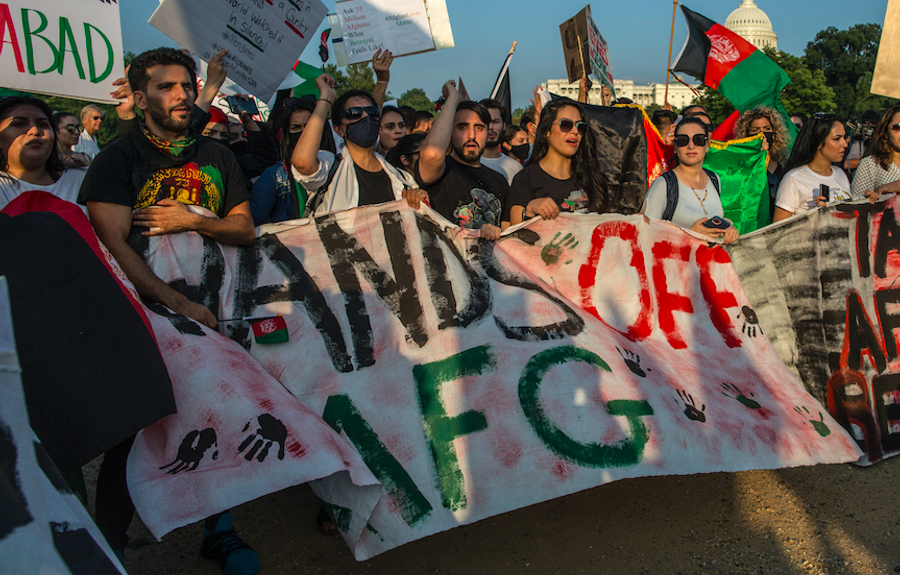Afghanistan and Beyond: End U.S. War-Making Everywhere
We need a reinvigorated anti-war movement.
Azadeh Shahshahani

The U.S. withdrawal from Afghanistan, after 20 years of brutal occupation, should just be the beginning. The United States must also end the disastrous “War on Terror,” including the bombing campaigns targeting Somalia and Yemen. And it must also put a stop to the brutal sanctions against Cuba, Venezuela, Iran and other countries in the Global South.
But it’s not enough to merely stop the harm: The United States must also make amends. This means paying reparations to the people of Iraq, Afghanistan and other countries it has invaded and exploited, and providing refuge to any citizens of those countries who are fleeing because of the destruction and destabilization wrought by the United States.
The stakes could not be higher. The full cost of U.S. war-making during the past 20 years is tremendous. The Costs of War, a Brown University Watson Institute of International and Public Affairs project, recently estimated that post-9/11 U.S. wars have killed between 897,000 and 929,000 people in Afghanistan, Pakistan, Iraq, Syria, Yemen and other countries since 2001. The true number may be even higher: One study conducted by Opinion Research Group estimates that more than 1 million Iraqis have died as a result of the Iraq War since the U.S.-led invasion in 2003.
Bombings
In 2007, former President George W. Bush started the airstrike campaign in Somalia, and since then at least 254 declared U.S. actions have taken place in the country. Airwars, which took over the work of recording airstrikes from the Bureau of Investigative Journalism in 2019, estimates that anywhere between 70 to 143 civilian deaths in Somalia are the result of 31 U.S. separate actions between 2007 and 2021, 18 to 21 of those children. U.S. Forces only concede to five of those civilian casualties, the rest of which are either unacknowledged or claimed to be “unsubstantiated.”
The current administration has continued this lethal campaign. On July 20, the U.S. military carried out its first airstrike in Somalia under Biden, followed by another airstrike only three days later, a sign that the undeclared war will continue to take lives.
U.S. “counterterrorism” operations officially began in Yemen in 2009 (although there were other bombings before that), with both the U.S. military and CIA launching airstrikes on the country. Since then, the country has seen possibly over 100 civilian deaths from U.S. airstrikes alone. U.S. forces only concede to 13 civilian deaths, according to Airwars.
However, most civilian casualties in Yemen are the result of Saudi-coalition bombings, which began in 2015 and are backed and supported by U.S. intelligence, as well as weaponry sales. After 23,470 coalition air raids, which consist of multiple individual air strikes, nearly 10,000 people were injured and nearly 9,000 dead as a direct result of the Saudi-led campaign.
In February 2021, Biden announced that the United States would end offensive support in Yemen while also helping Saudi Arabia “defend its sovereignty” against “threats from Iranian-supplied forces.” However, the announcement did not come with solid plans shared with Congress, and the Biden administration has failed to share details or plans to distinguish between offensive and defensive aid.
The bombings in Somalia and Yemen are just the tip of the iceberg. Based on official U.S. military data, Airwars concluded that the United States has carried out at least 91,340 airstrikes since 9/11 in the global “War on Terror.” The total number of civilian deaths directly attributed to U.S. airstrikes is estimated to be at least 22,679 but could be as high as 48,308. The data is collected from U.S. operations in Afghanistan since 2006, Iraq from 2003 to 2013, Iraq and Syria from 2014 to 2021, Libya since 2012, and a once-secret drone campaign in Pakistan, Somalia and Yemen. Overall civilian harm is likely higher because of the collateral consequences of U.S. bombings and other military actions in these regions.
Bloated budget
Despite withdrawing troops from Afghanistan, the U.S. war budget continues to expand. The watchdog group Public Citizen notes that the Biden administration actually requested a 1.7% increase in overall military spending — for a whopping $753 billion, an increase that is roughly on par with inflation. While some members of Congress resist high levels of military spending, 14 House Democrats recently sided with Republicans to increase the request by almost $25 billion. The primary justification for more spending is the increasingly confrontational stance toward China.
Sara Kate Baudhuin of Public Citizen recognized that the requested budget for the Department of Defense would be larger than the budget for the Departments of State, Justice, Health and Human Services, Education, Transportation, and the Environmental Protection Agency combined. On the topic of defense funding, Brown University’s Costs of War project reported the Pentagon has spent $14 trillion dollars of public funds from 2001to 2021. One-third to one-half of this total went to five weapons companies: Lockheed Martin, Boeing, General Dynamics, Raytheon and Northrup Grumman. Investments in defense stocks are now worth almost 10 times what they were when the war in Afghanistan first started. Public Citizen called this out for what it is, saying that “The only “winner” of the Afghanistan war was the military industrial-complex.”
Biden’s proposed budget allocated $15.2 million for a “Sea-Launched Cruise Missile,” a nuclear weapon Biden himself called a “bad idea” during his campaign. The plans are a remnant of the Trump administration and, while Biden could have cancelled it, his administration has chosen to maintain the project and add to what Kingston Reif, the director for disarmament and threat reduction policy at the Arms Control Association, describes as the U.S. military’s “already extensive and growing nuclear arsenal.” The Center for Arms Control and Non-Proliferation calls the project “a costly solution to a nonexistent problem.” It was eliminated by the House Defense Appropriations Subcommittee.
The bloated budget is a continuation of total military spending on the “War on Terror.” The Institute of Policy Studies reviewed publicly-available Office of Management and Budget data, reporting that the United States has spent $21 trillion on foreign and domestic militarization, surveillance, and repression between the federal years of 2002 to 2021.
Global empire
All the while, the United States maintains military bases around the world.
Maps of U.S. military presence are not readily available and many bases are intentionally kept secret. There are also many military affiliated spaces that hold U.S. weaponry, but are not deemed official “U.S. bases.” David Vine, an anthropologist at American University, said the United States might have “800 military bases in more than 70 countries and territories abroad.”
In 2007, the United States established U.S. Africa Command (AFRICOM). Since then, U.S. military presence on the continent increased from 2,600 personnel to 7,000 by 2019. Military presence through official and unofficial bases spans the continent from coast to coast. The Intercept, citing official Pentagon records, revealed that, as of 2019, there were 29 verifiable bases across 15 different countries or territories within the AFRICOM “area of responsibility,” which covers all countries across the continent besides Egypt.
In 2017, it was revealed that U.S. commandos were actively engaged in military action, despite AFRICOM’s claims that they were only providing “advice and assistance.”
U.S. Indo-Pacific Command (INDOPACOM), which has an “area of responsibility” spanning most of East Asia and the Pacific Island nations, asked Congress for $27 billion in additional funds between 2022 and 2027. The funds are meant to “boost deterrence against China,” as Defense News put it, with new missiles, air defenses, radars, supply depots, testing ranges, and more. Communities in the Pacific Ocean are still suffering from the remnants of U.S. military nuclear testing, while the United States is continuing its escalation against China.
The network of overseas bases not only creates a harmful presence, but also actively makes conflict and war more likely. Scholar David Vine, in his book The United States of War, explains that after World War II, the United States has had “unparalleled military power and an unparalleled global military presence.” Troops are permanently deployed worldwide in strategic locations, ready to further U.S. economic, political and military interests under the threat of violence.
Sanctions
Meanwhile, the United States is continuing to engage in other forms of warfare such as sanctions targeting Cuba, Venezuela, Iran and other countries in the Global South.
U.S. sanctions against Cuba began in the 1960s. In 1992, with the Torricelli Act, U.S. presidents gained the ability to sanction countries that aided Cuba and prohibit foreign subsidiaries of U.S. companies from trading with Cuba. In June 2021, a total of 184 countries voted in favor of a resolution to demand the end of the U.S. economic blockade on Cuba — only the United States and Israel voted against. Food and medicine shortages are widespread; this has contributed to the unrest erupting across the country. The island has faced its worst food shortages in 25 years. Cuba’s national food import company, which is vital since it imports 70% to 80% of its food, reported that it lost $45 million because it could not engage in direct transactions with U.S. banks. Even though the United States technically allows the sale of food to Cuba, the tightening of economic sanctions hinders Cuba’s ability to afford adequate food supplies.
U.S. officials often say that humanitarian aid is exempt from the sanctions. However, humanitarian exemptions are not very effective in practice. Even though medicine and medical supplies can technically be licensed for export to Cuba, many restrictions and barriers have resulted in a “de facto ban on critical medical and other assistance,” a reality taht the American Association for World Health pointed out in 1997 that persists to this day. The conditions governing the licensing process, meanwhile, make export extremely difficult.
As for Venezuela, the oil embargo imposed under Trump and maintained under Biden, has been very harmful, since the country receives 90% of its revenue from the oil industry. Like Cuba, Venezuela imports a majority of its food, and the fall in oil production has caused currency devaluation and a contraction of food imports. The reduction in food imports due to sanctions has resulted in the steady worsening of malnourishment over the past six years, with 2.5 million Venezuelans severely food insecure.
The United States has also been imposing economic sanctions on Iran, in varying degrees of extremity, since 1979. In 2018, the Trump administration pulled the United States unilaterally out of the Iran nuclear agreement, known as the Joint Comprehensive Plan of Action (JCPOA), and re-imposed what it termed “maximum pressure” sanctions on Iran. The administration tacitly admitted that the sanctions were meant to make people suffer to induce protests. Many Trump-era sanctions remain in place.
While U.S. sanctions technically exempt medicine and medical equipment, the fear of secondary sanctions have left many countries that produce Iran’s necessary medicines unable to find banks that are willing to authorize transactions for supplies going to Iran. The most stringent sanctions on Iran’s financial sector have made it nearly impossible to transact in these goods. Even though Iran manufactures 97% of its medicine needs, the 3% that it has traditionally imported include essential treatments for serious diseases like cancer. Covid-19 has also absolutely ravaged the country, with more than 115,000 deaths from February 2020 to mid-September 2021, and Iranian doctors have warned that the sanctions have made the outcomes far worse.
Natasha Hakimi Zapata, writing for In These Times, criticizes the United States for imposing sanctions on two-dozen countries “from the Balkans to Zimbabwe” as of 2021. Sanctions are a bipartisan project of U.S. imperialism. The Biden administration has maintained the harsh sanctions on Nicaragua, Venezuela, Sudan, and Ukraine from the Trump era, additional sanctions on Cuba, Iran, China, Syria and Russia, and brand-new sanctions on the Balkans, Belarus and Burma.
While the withdrawal of U.S. troops from Afghanistan is the first necessary step in ending the U.S. legacy of violence, much is yet to be uncovered about the true toll of the U.S. invasion and 20-year-occupation.
Malalai Joya, a women’s rights and human rights activist and former Afghan Parliamentarian, told Democracy Now! in July, “For years I have called for the withdrawal of the foreign occupation from our country… Now it has been proved for our people, as well, that U.S. and NATO were not honest for them… The blood of Afghan people has no value for them.”
In addition to pursuing refuge for those fleeing for their lives and reparations for the people of Afghanistan as well as Iraq, it is time to end all U.S. wars, shut down all U.S. military bases, and put an end to U.S. militarization and sanctions impacting countless people in the Global South. We need a reinvigorated anti-war movement led by and taking direction from people of color and those who are directly harmed by U.S. wars and militarization. The people of the Global South cannot afford any more U.S. militarization and violence. It is on us to put a stop to it.
The author would like to thank law students Erum Kidwai and Divya Babbula for their research support for this article.
Azadeh Shahshahani is the Legal and Advocacy Director at Project South: Institute for the Elimination of Poverty and Genocide and a past president of the National Lawyers Guild.








